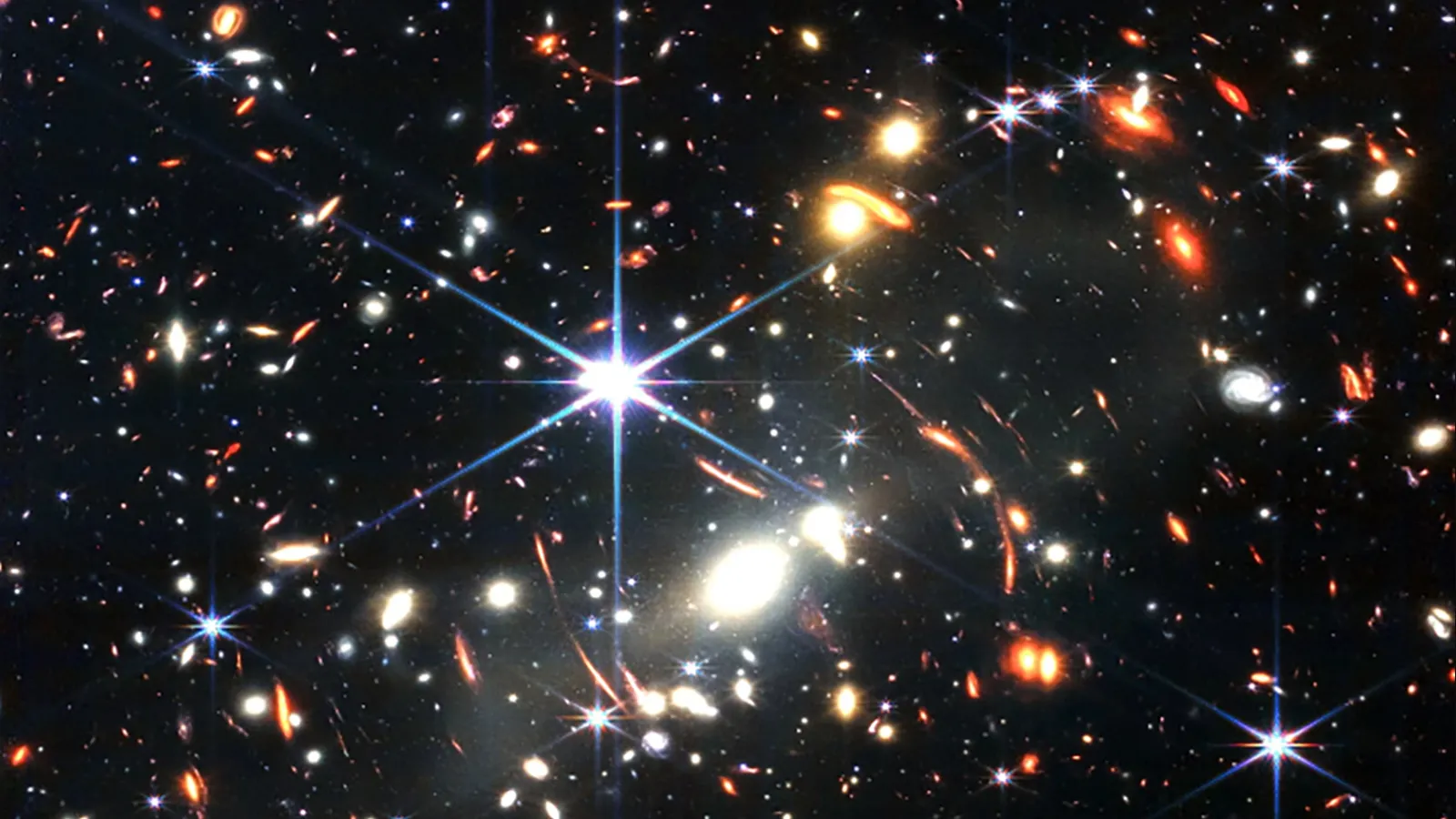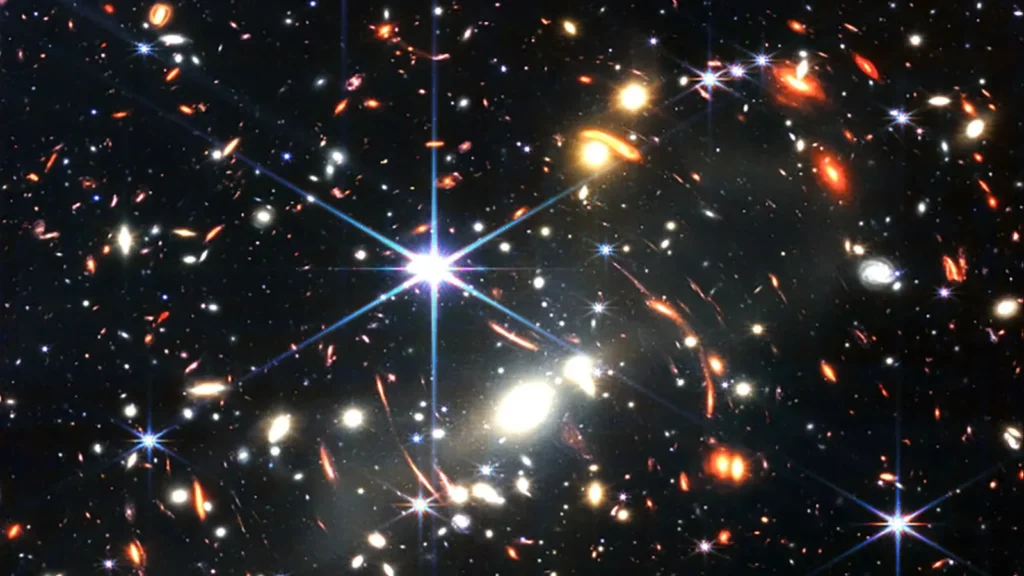Physical Address
304 North Cardinal St.
Dorchester Center, MA 02124
Physical Address
304 North Cardinal St.
Dorchester Center, MA 02124
With Michael Walker
With Michael Walker

Something to think about….

When we look into the Deep Field images captured by the Hubble or James Webb telescopes, we are gazing into a seemingly limitless field of stars and galaxies—thousands upon thousands—all packed into a tiny segment of the sky. What we are told is that these galaxies are billions of light-years away, and because of that, they must be billions of years old. This is the dominant narrative in secular cosmology: distance equals time, and time equals age. But as we begin peeling back the layers, we find that this assumption—while convenient—is built upon a simplified framework that ignores the deep, tangled, and warped structure of the universe itself.
The Deep Field Deception: Thousands of Galaxies, One Flawed Assumption
The Deep Field images are jaw-dropping. In just a minuscule sliver of sky, there are more galaxies than we can count—each filled with billions of stars. From a secular perspective, this serves as evidence of an incredibly old universe. Why? Because light takes time to travel, and if that light had to journey from these far-flung galaxies to Earth, and if it moves at a constant speed, then it must have taken billions of years to get here. But that entire framework hinges on two shaky assumptions: (1) that space is smooth and uniform, and (2) that light has only one clean, direct path to travel.
The reality is much messier. Each of these galaxies is not just sitting there quietly. They have mass. Mass means gravity. Gravity bends spacetime. And when you have thousands of galaxies in a single image, each distorting the very fabric of the cosmos, you’re not looking through a clear window—you’re looking through a chaotic field of gravitational warping.
Stage 4 Distortion: Gravity, Dark Matter, and the Hall of Cosmic Mirrors
This is where the term “Stage 4 gravitational distortion” comes into play—an analogy that captures the overwhelming presence of warped spacetime within the Deep Field image. Just as cancer advances in stages, this image reveals a universe saturated with warping, bending, and curvature that is far from linear. Every galaxy in that image acts like a lens, bending the light that comes from even more distant sources. This is gravitational lensing, and it’s not a minor effect. It can bend light around galaxies, delay it, split it, and stretch it—making a single source appear in multiple locations or at multiple times.
Add dark matter to the mix—an invisible but gravitation-heavy component of the cosmos—and the distortion becomes even more intense. Dark matter bends light and time without being seen. It adds another layer of curvature to the universe. Light isn’t moving through a void; it’s moving through a minefield of distortions, dragging itself through a medium that warps every step of the journey.
The Brillo Pad Analogy: Rethinking Space as Tangled Mesh, Not a Void
Let’s forget the overused metaphor of a bowling ball on a blanket. That visual is misleading because it represents space in two dimensions and assumes some external force (gravity from Earth) is pulling the ball downward to bend the sheet. It doesn’t reflect the real behavior of gravity, which works in all directions.
Instead, imagine space as a Brillo pad—a tangled, chaotic, three-dimensional mesh. This is far more accurate. Light doesn’t glide across a smooth surface—it struggles through a fibrous, knotted lattice of distorted spacetime. Each strand of that mesh is warped by nearby mass, accelerated expansion, time dilation, and unseen gravitational fields. That means every beam of light traveling from a galaxy to our eyes is passing through a cosmic sponge—its path twisted, its speed distorted, and its age misrepresented.
In this framework, we begin to understand why light from galaxies that appear to be billions of light-years away may not have taken billions of years to get here. The apparent age is a function of the warped mesh—not of actual distance or time.
Painting the Picture: Nested Spheres and Contracting Cubes
To truly visualize this distortion, imagine a star—a sphere—floating inside a cube that represents its local region of spacetime. The star, because of its mass, bends spacetime inward on all six faces of the cube. Gravity is not just “downward”—it’s omnidirectional, pulling the fabric of the cube toward the center from every side.
Now scale up. Replace the star with a galaxy. The cube becomes far larger, but the same gravitational principles apply: the entire cube of space around the galaxy bends inward toward the galactic core. But now add two more forces: dark matter, which contracts space even further, and dark energy, which simultaneously expands it. You now have a dynamic region where space is bending inward while expanding outward—compressing and stretching at once.
Now scale up again. Imagine a cluster of 10,000 galaxies inside a far larger cube. That entire cube bends inward on all six sides toward the galaxy cluster, even as each individual galaxy continues warping its own cube of space, and each star within them bends space within its own microcube. All of this—every contraction, expansion, and gravitational lens—is happening simultaneously.
This is the Brillo Pad Network. Space is not flat. It is endlessly nested fields of warping, bending, stretching, and contracting spacetime. When light travels across these layers, it doesn’t take a straight path. It weaves through a multidimensional jungle gym of distortion.
Wormholes and FTL: How Natural Curvature Could Have Shortened Light’s Path
Here’s where the analogy reaches genius-level insight: if bending space can allow for faster-than-light travel—by bringing two points in spacetime together—then what happens when the universe itself is already bent? In theory, we often describe faster-than-light travel through the concept of wormholes or Einstein-Rosen bridges: punch a hole through spacetime so point A connects directly to point B. But if spacetime is already warped like a Brillo pad, then the path from point A to B is naturally shortened through these curves.
That means light could travel a far shorter effective distance—even if we perceive it as having crossed billions of light-years. In reality, the space was folded. The shortcut was already there. The mesh did the work. We’re seeing the result, but not the real journey.
And this isn’t pseudoscience—it fits within the bounds of accepted physics. General Relativity tells us that spacetime is malleable. Time can dilate. Gravity can warp the passage of time and alter the path of light. Combine this with an expanding universe, dark matter, and unknown quantum foam—and suddenly our simplistic light-speed calculations begin to collapse under their own assumptions.
6,000 Years or 13.8 Billion? The Warped Framework of Time Itself
Now here’s the theological bombshell: if the observable universe is embedded in this warped, tangled mesh—and if light has traveled through that mess—then the apparent age of the universe may be nothing more than a cosmic illusion. It appears ancient not because it is ancient, but because we are misreading the scars of distortion as the passage of time.
God could have created the universe mature. Not fake. Not deceptive. But fully formed. Just as Adam wasn’t made as a baby but as a man, the universe may have been spoken into existence with stars and light already in motion—because they were created for signs, seasons, and illumination (Genesis 1:14). What sense would it make for those lights to remain invisible for billions of years?
This perspective allows for a literal 6,000-year timeline without contradicting observable phenomena. It reframes the narrative—not by denying science, but by reinterpreting it through a multidimensional lens. The universe doesn’t have to be old just because it looks old. Not when space is warped. Not when time is elastic. Not when God Himself bends dimensions and holds the fabric in His hand.
Conclusion: When God Speaks Light, Who Are We to Tell Him How Long It Took to Arrive?
The Brillo Pad Universe forces us to reconsider what we’re really looking at. Are we seeing age—or are we seeing distortion? Are we looking through time—or through tangled, multidimensional spacetime that twists our perception of reality?
The answer is profound: the universe may not be a time machine—it may be a hall of mirrors, reflecting warped light from a mesh we barely understand. When we look at the heavens, we are not measuring the past—we’re interpreting signals distorted by gravity, curvature, and unseen forces.
And if God created that mesh, then He wrote the rules of distortion, too. Which means a 6,000-year-old universe can still display the glory of a 13.8-billion-year-old cosmos—without contradiction, without error, and without bowing to human assumptions.
So maybe we should stop measuring eternity with rulers we made in a lab.
Maybe, just maybe… God’s glory doesn’t need our math to be true.